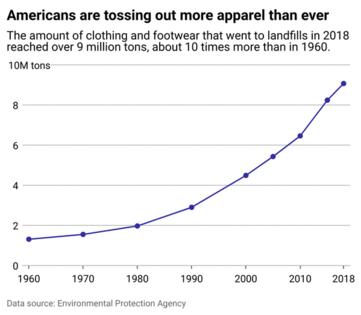Textile waste is a major environmental threat. Here's what's being done about it.
Published in Slideshow World
Subscribe
Textile waste is a major environmental threat. Here's what's being done about it.
Behind the convenience and flashiness of fast fashion lie its unsustainable practices and ecological consequences, from the making of plastic-derived textiles to its disposal. According to the Environmental Protection Agency, the textile industry sent 11.3 million tons of waste to landfills in 2018, making up about 7.7% of all municipal solid waste in landfills. On a global scale, a working paper from the World Resources Institute and the Apparel Impact Instutute estimated that clothing and textile waste accounted for approximately 2% of greenhouse emissions in 2019.
The rapid production and disposal of clothing leads to stuffed landfills, where textiles get stuck in an environment without oxygen. As these materials suffocate and decompose, they release methane gas, an emission more potent than carbon dioxide.
Even other methods of discarding, destroying, or otherwise not recycling textiles require significant energy, such as incineration, which releases carbon dioxide and other emissions into the air. Additionally, the disposal, destruction, and even the washing of many synthetic fabrics, such as microfiber, can release microplastics into the water and air. According to the United Nations Alliance for Sustainable Fashion, textiles produce approximately 9% of the microplastics in the ocean.
Despite these dire statistics, people continue their fast pace of consumption when it comes to clothing. According to Market Data Forecast, over the next five years, the fast fashion market is estimated to grow 14% every year to reach nearly $90 billion by 2029. And yet, just 14.7% of all textiles were recycled in 2018 according to the latest figures from EPA.
To further explore the impact of fast fashion practices on society and the environment, The RealReal examined data from the Environmental Protection Agency, the United Nations, and other sources to explore the growth of textile waste and what's being done about it.
Visit thestacker.com for similar lists and stories.
What's behind the growth in textile waste?
As trend-driven fashion purchases increase, so too does the amount of clothing and footwear that ends up in American landfills—now, at a rate of "one garbage truck per second," according to a paper published in the journal Materials Circular Economy in 2021. In 1960, clothing and footwear generated equalled 50,000 more U.S. tons than what was landfilled, per EPA data. By 2018, the gap between generated and landfilled clothing and footwear increased dramatically to 3.9 million U.S. tons.
Destroying the clothing that remains through incineration also has significant environmental impacts. According to a 2020 article by the Princeton Student Climate Initiative, such processes also present health and environmental hazards to nearby communities, with pollutants contaminating the air, water, and soil, often dramatically affecting marginalized communities.
This broad systemic issue was first revealed in a 1979 lawsuit by Robert Bullard, a pioneering scientist and civil rights leader who collected and published data linking race and health issues with disproportionate exposure to pollution in predominantly Black neighborhoods. His research found that six of Houston's eight incinerators were in Black neighborhoods, effectively dumping 85% of the city's garbage on 25% of the population at the time.
It's not just disposal, either. Clothing production processes, such as clothing dyes leaking into drinking sources, are also linked to increased health issues inpopulations living near polluted water systems in China, India, Bangladesh, Indonesia, and Zambia. Within the United States, there are racial-ethnic disparities for almost all types of emissions regardless of income level, according to a study by the EPA published in 2021.
How countries are combating textile waste
As production continues its lightning clip, the burden of acting has been placed on county officials around the world. According to a 2022 report by Boston University's School of Public Health, if the 34 billion pounds of textiles the U.S. discards each year were evenly distributed among the country's population, it would equate to each person tossing 100 pounds of textiles yearly. However, it is China that currently leads the world in fast fashion decomposition, with 26 million tons of clothing discarded per year, according to a 2024 Associated Press report.
China also leads the world in textile exports, with the World Trade Organization reporting the country exports more than a third of the world's supply in 2022. In response, China is establishing a system to recycle a quarter of its textile waste by 2025. Its National Development and Reform Commission says it plans to increase that target to nearly a third by 2030.
Bangladesh, the third largest textile exporter in 2022, comes second to the European Union, which includes 27 countries. Bangladesh's economy currently relies on apparel production, as it comprises 84% of its total export revenue, according to the World Economic Forum. As it emerges from its classification as one of the least developed countries, the United Nations has encouraged the country to adopt textile recycling processes by bringing together representatives from Europe and Bangladesh. Meanwhile, textile workers in Bangladesh, particularly women, do labor-intensive work sorting scraps and repurposing materials to support their families, according to an article published by the policy institute Chatham House.
The United States is taking action, too. In California, Gov. Gavin Newsom signed the Responsible Textile Recovery Act of 2024, introducing the first textile recycling program that requires certain apparel manufacturers to take accountability for the "end-of-life" of their products through reuse, repair, and recycling methods.
These large initiatives, however, do not have enough momentum without consumer demand and willpower. One of the most sustainable ways to buy clothing is to choose second-hand items. Though fast fashion offers affordable and trendy apparel, the low quality of materials can often mean customers are left to buy clothes more often. Meanwhile, vintage clothing can be timelessly trendy and has a track record lasting through the years. Shoppers can also advocate for more responsible manufacturing from brands. Efforts like these can help lead to reductions in environmental harm, encouraging a more sustainable pattern of consumption.
Story editing by Carren Jao. Additional editing by Elisa Huang. Copy editing by Kristen Wegrzyn.
This story originally appeared on The RealReal and was produced and distributed in partnership with Stacker Studio.









Comments